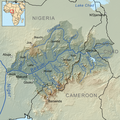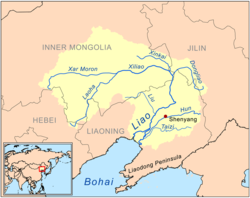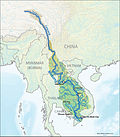Tributary
A tributary of a river is another river that flows into it. If one river flows into a second river, then the first river is a tributary of the second river. A tributary is a body of water that flows into another body of water.
The opposite of a tributary is a distributary. A distributary is a river that branches off from the main flow of water, for example in a river delta.
+{{{1}}}−{{{2}}}
Tributary Media
Nam Khan flows into the Mekong at Luang Prabang in Laos.
At Harpers Ferry, West Virginia, looking downstream, the Shenandoah River (bottom right) meets the Potomac River, which flows from bottom left to top right, making the Shenandoah a right tributary of the Potomac.
The Benue River is fed by multiple tributaries originating in the Adamawa Plateau; many of the highest tributaries are seasonal streams. The Benue is itself a major tributary of the Niger.
Huai River (itself a tributary of the Yangtze) and tributaries
The Liao River is a much simpler example of a river basin with tributaries. The main tributaries noted on this map are the Hun River, Taizi River, Dongliao River, Xinkai River, Xiliao River, Xar Moron River and the Laoha River. The Xiliao River's tributaries are the Xar Moron and Laoha rivers.
The Mekong is a trans-boundary river, originating in the Tibetan Plateau. Its upper tributary river systems (e.g. ngom chu) are restricted to narrow gorges, but the tributaries that feed its lower reaches (e.g. the Mun River) cover larger areas.
The water basin of the Wabash River; the other rivers (not including the Ohio River) are tributaries of the Wabash River. The Vermillion River (and its forks) is a highlighted example of a tributary of the Wabash River. The Wabash River is also a tributary of the Ohio River, which in turn is a tributary of the Mississippi River.
The Yamuna is the second-largest tributary river of the Ganges and the longest tributary in India. It flows almost parallel to the Ganges about its right bank for 1,376 kilometres (855 mi) before merging with it at the Triveni Sangam, Allahabad.







